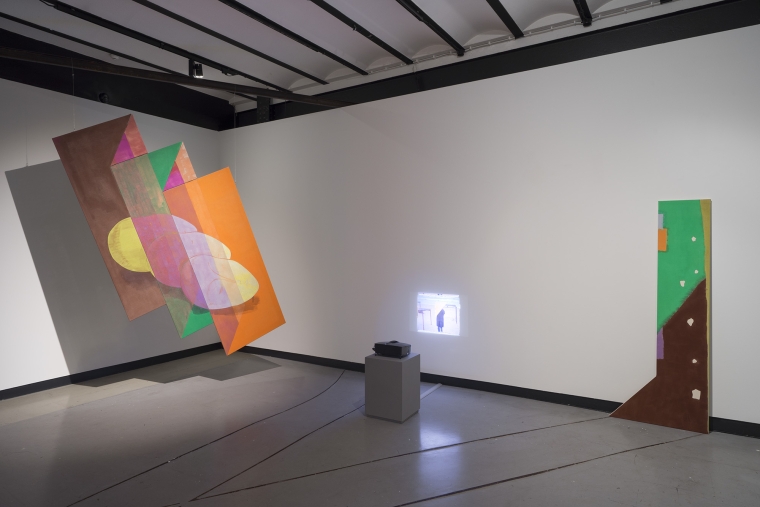

|
Film stills from Terra-Triangular, 2022–2023, by Ana Cardoso. Super 8 film transferred to digital video; 4 min 16 s. Music by Tim Pierson. |
Ana Cardoso: Camouflage Games
João Pinharanda
In Ana Cardoso’s work, the mix (or layering) of rigorously shaped geometries along with drawing and painting’s free gestures has grown increasingly evident. While geometry sets the formats (the canvases), gesture commands the drawing and colour distribution within those formats.
By linking only two or several shaped canvases and by filling them completely with non-figurative painting, the contradicting values that clash in these works end up confirming indiscipline’s dominance over rigidity. Converging drawing, colour and form, the shaped canvas used to incorporate late modernism’s aims of “truth” and “specificity”. Cardoso, whose exposure to North American minimalist and post-minimalist painting is crucial to understanding how her work was informed and evolved, explores some of these movements’ elements in a process that consciously sabotages modernism.
She first introduces a seism that steers the rigidity of the shaped canvas towards certain Op Art game logics, where the canvas was occasionally part of recurring formalist games of illusion and trompe l’oeil. A second quake calls into question the very principles of this Op Art drift: in multiplying the number of small shaped canvases and expanding them rhizomatically in space, Cardoso annuls any austere geometry and explores provocative decorative derivations within it. Folding and unfolding the canvases’ sequences, some paintings spread across the walls, challenging the geometric rigidity of each isolated element (triangles, squares, etc). There are no geometric rules governing the seed of formal complexity in these infinite puzzles, despite the configurations and their elements’ modular proportions; and the conflicting colours that occupy them (blobs, elemental and printed figures) do not conform but rather deconstruct the geometry that contains them.
This set of paintings springs from a collection of loose discursive fragments assembled from both historicist knowledge and the artist’s own daily and familial life (as shown in the humour of many titles). Chance seems to overpower strictness and an explosion of creative energy appears to engulf any control over the medium’s available resources; however, the colours and forms found in the chromatic and gestural chaos of each painting (children’s toys, reminiscences of female nudes in the history of western painting, Matisse and Brancusi quotations) stem from pondered and conscious decisions (namely the reclamation of the scopic male gaze at the female body) – they are not mere unconscious flowerings.
Another of the more evident conscious and planned decisions (taken always from a seepage and sabotage viewpoint) relates to the production of dyed surfaces (from natural pigments) that, instead of being painted, are attained through manual weaving. Included in the puzzles comprising the paintings, these elements purposefully go unnoticed. They gain autonomy though, when presented as “curtains” or “backdrops”. Too fragile to identify as sculptures, if given the status of Duchamp’s inframince, they can be regarded (hanging and undulating) as contact surfaces or membranes in between spaces and realities, assuming a metaphorical status of separation and permeability that goes far beyond the definition of mere three-dimensional spaces.
The short film Terra-Triangular [Triangular-Earth], 2022–2023, in which the artist slowly moves a triangle from one of her paintings through urban and natural spaces, or over certain natural elements, eliding or uncovering them, perfectly concludes the series of games (of power and sabotage, camouflage and identification, quotation and infiltration) that make up this exhibition, Leaky Abstraction by Ana Cardoso.
|
Leaky Abstraction (maat, 29/03–17/09/2023), an exhibition by Ana Cardoso, is based on this artist’s research around the medium of painting. Exploring optical illusions allowed by the geometry of forms and a gestural and material based painting, Cardoso combines and simultaneously sabotages historical solutions of hard-edge and abstract painting with craft based practices: mixing or connecting dyed and hand-woven unpainted canvases with hand-painted industrial canvases, for instance. In her work, abstraction is grounded by a structure regulated by modular and geometric forms that are both independent and generic (although defined by the artist), – references to the history of abstraction, formalist strategies, etc. – as propositions for and of the body.
|
Ana Cardoso lives and works between New York and Lisbon. Her practice provides a singular take on abstraction, performance, and installation through the reinterpretation of painting and its limits in varying contexts. Cardoso deconstructs the usual rectangular forms and, pushing away from an anchoring geometry, approaches organic and material solutions. With an MFA in Painting (Hunter College, New York) and a BA in Painting (Faculty of Fine Arts – University of Lisbon), she was a grantee of the Pollock Krasner Foundation (New York, 2019–2020) and a finalist of the EDP Foundation New Artists Award 2017. Her work was shown at Galeria da Boavista / Galerias Municipais (Lisbon, 2022), Fundação Calouste Gulbenkian (Lisbon, 2019), Parapet Real Humans (St. Louis, 2018), Museu Nacional de Arte Contemporânea (Lisbon, 2015), among other venues.
|






